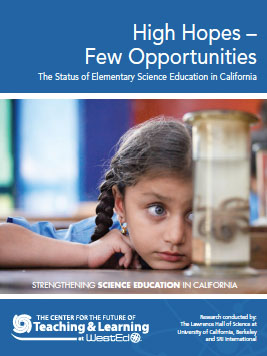Teachers have little time to teach science, study shows

Intense pressure to meet accountability goals in mathematics and English is limiting time for science, and teachers and schools do not have the infrastructure support needed to consistently provide students with quality science learning opportunities. Forty percent of elementary teachers say they spend just 60 minutes or less teaching science each week. Just one-third of elementary teachers say they feel prepared to teach science, but 85 percent of teachers say they have not received any professional development in science during the last three years. And while nine in ten principals say science education is very important and should start early, less than half of principals (44%) believe it is likely that a student would receive high-quality science instruction in his or her school.
“Children in California’s elementary schools rarely have the opportunity to engage in high-quality science learning because the conditions that would support such opportunities are rarely in place,” says Dr. Rena Dorph, a researcher at the Lawrence Hall of Science at the University of California, Berkeley. “Analysis of our elementary teacher survey data suggests that high quality science learning opportunities are only available in about 10% of California elementary school classrooms on a regular basis.
These findings and others are found in High Hopes – Few Opportunities: The Status of Elementary Science Education in California, a new report examining the results of a statewide study of science education conducted in 2010 and 2011 among teachers, principals and school district leaders in California, as well as analysis of secondary data and case studies in selected school districts. The study was commissioned by the Center for the Future of Teaching and Learning at WestEd and conducted by the Lawrence Hall of Science at the University of California, Berkeley, and SRI International as part of their Strengthening Science Education in California Initiative.
“While educators and the public believe strongly that science is essential, science education is not a priority in California’s elementary schools,” says Holly Jacobson, Executive Director of the Center for the Future of Teaching and Learning at WestEd. “Almost all teachers say they have too little time to teach science and more than eight in ten cite the emphasis on English and math as a challenge to teaching science. It’s clear that accountability mandates leave little time for teaching science. And almost all schools are feeling the pressure.”
The research also finds that the infrastructure support and resources needed for quality science education are scarce. Just one-fifth of school districts provide science related professional development for elementary teachers, and few school districts have science specialists or coordinators. More than 60 percent of all school districts have no district staff dedicated to science. Two-thirds of elementary teachers cite limited funds for equipment and supplies as a challenge to teaching science. More than half of teachers say they lack access to needed facilities.
“California’s elementary schools have very little of the infrastructure support needed to provide and strengthen science education,” says Patrick Shields, Director of the Center for Education Policy at SRI International.“ Critical supports are in short supply.”
The report’s authors also note that while the challenge of providing high-quality science learning opportunities affects most elementary schools, those serving low-income students may face additional challenges.Principals in more affluent schools are more than twice as likely to report having launched science initiatives over the past five years than those in the state’s poorest schools, and those schools serving poor students are less likely to have access to facilities such as science labs or dedicated classrooms. More than a third (35%) of elementary teachers in the schools serving the highest percentages of students in poverty identify facilities as a major challenge to teaching science, compared with 13 percent of teachers in the most affluent schools.
“On a somewhat more hopeful note, our research shows that a small number of elementary schools have found ways to provide a high-quality science program,” says Shields. Curriculum that engages students in the investigation and doing of science, time for teaching, and well-prepared teachers with access to support and resources can make a difference. It can be done, but doing so requires commitment, expertise, partnerships and resources.
“Ironically, the findings of our research stand in direct contrast to the public’s belief that science education should be a high priority for California’s schools,” says Dorph. “There is strong support for science education and the public wants schools and teachers to have the training and resources they need to teach science well.”
Public opinion research conducted in 2010 by Belden Russonello & Stewart for the Initiative found nearly nine in ten Californians believe science education should be a high priority for schools. Seven in ten Californians think having more resources and equipment would make a big difference in science education and more than half strongly support more training for elementary school teachers.
“California educators and the public clearly value and support science education, but students do not have the opportunities they need to participate in high quality learning opportunities in science,” concludes Jacobson. “Bold and urgent efforts are needed to address policies that limit time and attention to science education and strengthen the capacity of teachers and schools to teach the subject well.”
The report includes recommendations to assist educators and policymakers in efforts to strengthen science education in California. The recommendations call for an immediate review and revision of the state’s educational accountability systems, the restoration of a full and balanced curriculum, including science, for every student, and the establishment of adequate resource allocation and support systems needed to ensure high quality science learning experiences. The recommendations also encourage local school districts to make quality science education a priority.
High Hopes – Few Opportunities is published as part of the work of Strengthening Science Education in California, a research, policy and communications initiative funded by the S.D. Bechtel, Jr. Foundation to improve the quality of science education. Detailed research findings and recommendations from the report can be found on the web at www.cftl.org/science and here.
Full Report

Additional summary materials, as well as the findings of the 2010 public opinion research on science education in California are also available.
Contact: john.mcdonald@stonesthro.com, 310-798-3252 / 310-880-5332
